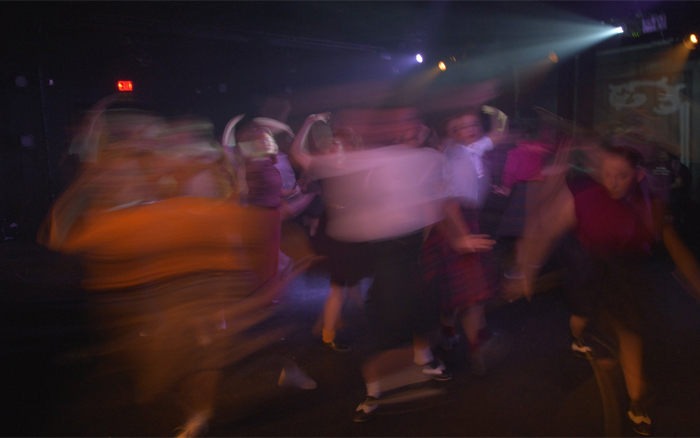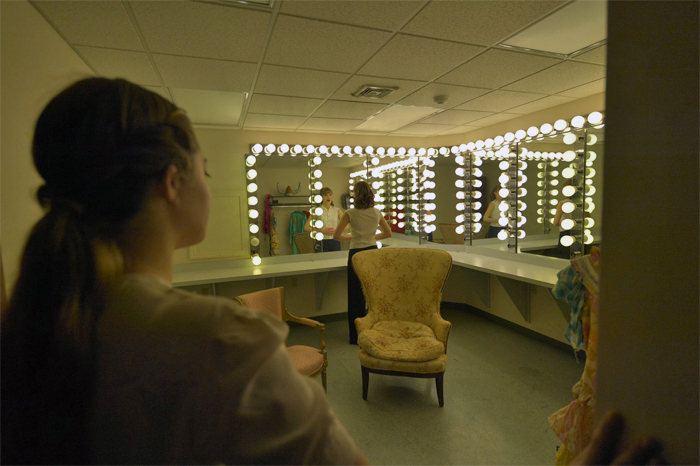Across Space and Time: Interactive DTG Performance Explores Carlisle Theatre History

Photo by A. Pierce Bounds '71.
Concert provides 'a completely different experience' to different audiences
by MaryAlice Bitts-Jackson
You don't have to hunker down on a war-battered plantation to enjoy Gone With the Wind, or shiver in an unheated attic to drink in La Bohème. Although these classics may make you feel like you're part of the action, you can't alter the goings-on. No matter where or when you view that movie or opera, the storyline will not change.
But what if the story's setting was also its venue? And what if your decisions could influence what you'd see, and when?
That is the premise of the 2018 fall Dance Theatre Group (DTG) concert, presented in downtown Carlisle, Friday, Nov. 16, and Saturday, Nov. 17, at 7 and 8:30 p.m.; and Sunday, Nov. 18, at 2 p.m. As DTG member Armando Moreno '20 explains, this site-specific concert is tailored to its Carlisle venue, and it's experienced differently by each audience member.
"This is not like a typical dance concert, where the audience is seated, waiting for each piece to come on," says Moreno, who joined DTG during freshman year and now majors in dance. "Instead, the audience is able to create their own experience throughout the show."
Project3 is a collaboration between Erin Crawley-Woods, visiting assistant professor of dance; and Matt Reeves and Colette Krogol, artistic directors of Orange Grove Dance. Orange Grove often performs in nontraditional sites, and Crawley-Woods invited Reeves and Krogol to collaborate on a work for the Cubiculo, a black-box venue on the second floor of the Carlisle Theatre. Kent Barrett, assistant professor of theatre design, designed the set.

Photo by A. Pierce Bounds '71.
Built in 1939 and restored to its Art Deco glory in 1993, the Carlisle Theatre is a longtime cornerstone of the local community, with a deep well of history—and in the months leading up the performance, Crawley-Woods and Barrett dived in. As a result, the choreography and multimedia elements, as well as costumes by Juli Bounds, costume shop manager and designer, hearken back to real-life performances, film screenings and events, evoking a sense of history. But unlike most performances inspired by particular places and events, this one can't be performed anywhere else. The dancers perform in dressing rooms, hallways and a conference room, as well as the stage. The choreography is both about and tailored to those very particular spaces.
That presents logistical challenges—not the least of which is getting audience members to move about so they can explore those nooks and crannies. Here's how it works: At the door, all audience members will receive a color-coded ticket, which will determine which of three small audience groups they'll join. As the performance begins, each group is led to a spot where a unique performance is underway.
“This means that each group is witnessing something different, so depending on what audience group you are in, you will have a completely different experience of the piece. Eventually, the piece becomes more of a self-guided adventure, in which audience members are free to move about the space on their own," says Crawley-Woods, explaining that, much as in an art gallery, audience members have the agency to choose what they'd like to see.
As they move from site to site, audience members also are encouraged to think about a sense of place across time. It’s multilayered and technically challenging stuff, and, Crawley-Woods is pleased to report, DTG's 21 members are up to the task.
“I’m particularly impressed with the dancers this semester,” she says. “This was unlike anything many of them have done; it required long hours of rehearsal, a lot of logistics, dancing in confined spaces and on carpets, walls and windowsills—surfaces that are much more challenging than a stage.”
But the success of the piece does not rely on the dancers alone, Moreno points out. "The audience is equally important to the experience," he says, adding that because audience members can customize their experience, "people can come see it multiple times and get a completely different experience each time."
TAKE THE NEXT STEPS
Published November 15, 2018